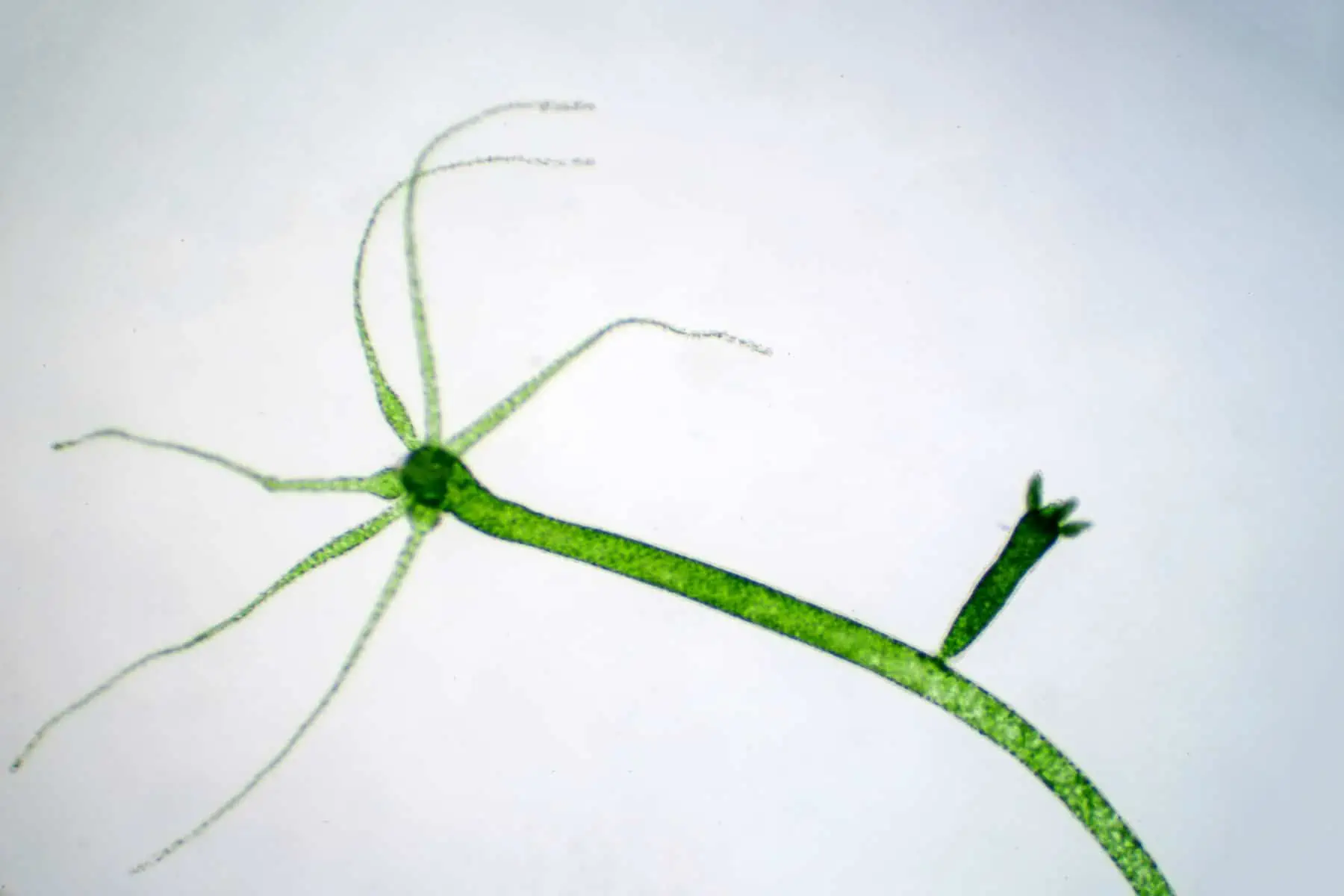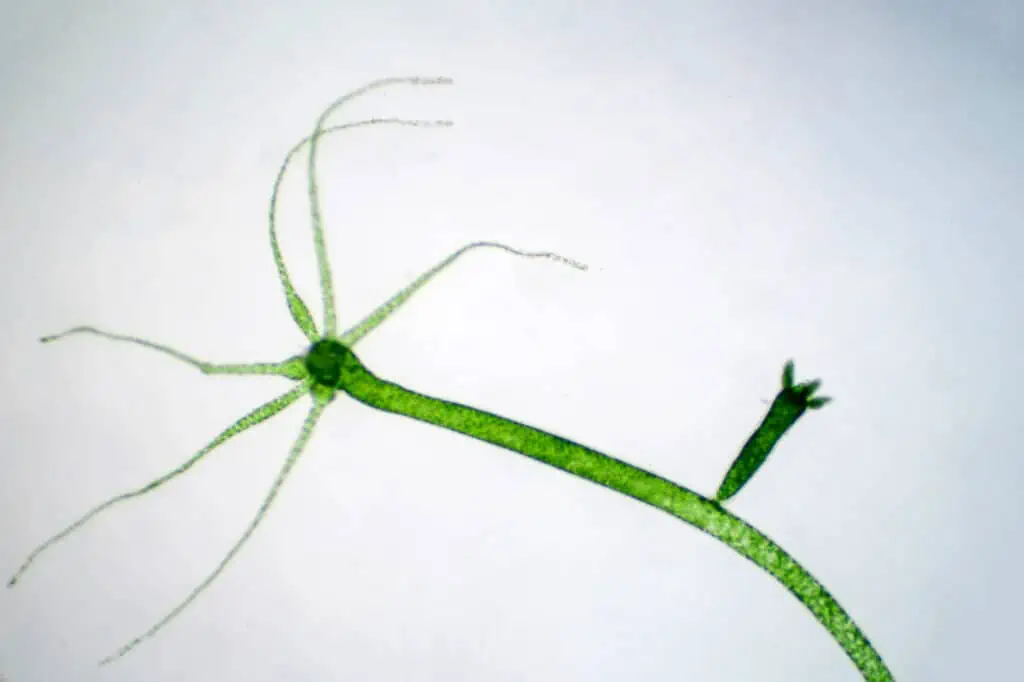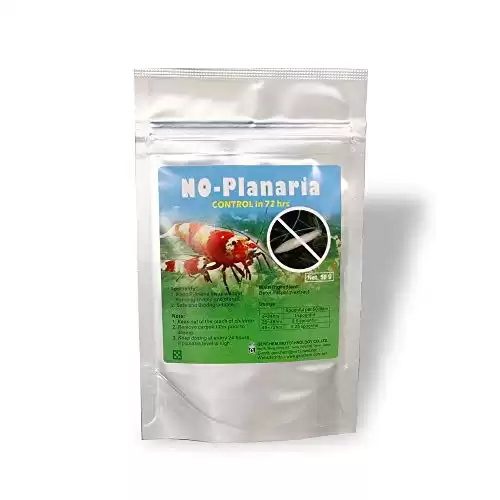The Hydra is the scourge of many fish tanks and is definitely not a creature that you want to have in your aquarium, especially if you have small fish or a breeder tank.
This guide explains how to identify, eliminate, and prevent a Hydra population from invading your setup!
Ancient Origins
The original Hydra monster is a mythical creature that appears in Greek and Roman mythology.
The Hydra of these legends was a many-headed, venomous, serpentine monster that was almost impossible to kill. Each time one of the Hydra’s heads was cut off, it would simply grow two more!
Don’t panic! You won’t find a multi-headed snake in your aquarium. However, the monster’s modern namesake can be just as deadly to small fish and fry and is equally difficult to eliminate once established in your fish tank.
So, What Is a Hydra?
The Hydra that can be a hobbyist’s nemesis is actually a soft-bodied polyp belonging to an ancient animal group, Phylum Cnidaria, which includes jellyfish, myxozoans, and corals.
The Hydra’s body is tubular in shape, with a sticky foot at one end and around a dozen tentacles at the other. Those tentacles are coated with stinging cells that the Hydra uses to immobilize its prey.
The creature has no brain, no musculature, no respiratory system, and no circulatory system. But don’t be fooled; this is a potentially lethal creature that you don’t want in your fish tank.
Ageless!
Some scientists estimate that a Hydra could live for as long as 1,400 years! These primitive creatures have certainly been around for a very long time and don’t look like they are disappearing any time soon.
Danger!
Hydra mostly feed on tiny aquatic organisms, including daphnia, aquatic crustaceans, and cyclops.
However, although that sounds pretty harmless, these nasty critters can also catch and eat small fish and fish fry. Adult shrimp are fairly safe since their hard outer carapace offers protection against the Hydra’s sting.
So, if you keep a breeding tank or a nano setup containing tiny fish, you can see why a Hydra infestation is such a nightmare.
Hydra are mostly seen in freshwater tanks. However, there are marine variants (Aiptasia) that are equally deadly to your livestock.
How To Identify the Hydra
The Hydra is pretty easy to identify once it’s in your fish tank.
As described above, the creature has a tube-shaped body that measures 1 to 20 mm long. The body is crowned with 10 to 12 tentacles of roughly the same length as the Hydra’s body.
All Hydra have a sticky foot at one end of their body that the critters use to fix themselves to objects in your tank, where they lay in wait for prey to swim past.
There are between 20 and 30 species of Hydra, and they can vary slightly in appearance. For example, if you have green Hydra in your tank, the creature’s tentacles might be slightly shorter than those of a brown Hydra.
Touch it!
If you’re unsure whether you have Hydra in your aquarium, all you need to do is touch one.
Hydra will curl up into a ball and flinch away from your touch, and don’t worry – you won’t get stung!
Divide and Conquer!
One of the biggest problems with Hydra is that they spread incredibly rapidly. Basically, you can start with just one tiny Hydra, only for it to become hundreds or thousands in a matter of weeks!
Not only does the Hydra’s ability to reproduce quickly make it difficult to eradicate, but the creature’s habit of moving around complicates matters, too.
Hydra reproduce asexually through a process called “budding.” The new Hydra forms as a “bud” on the side of the parent’s body, growing until it finally breaks away to create a clone of the original Hydra.
Some Hydra species can reproduce sexually, releasing sperm that reaches the eggs of another Hydra. The eggs can survive in extreme conditions of drought and freezing water thanks to a tough outer coating.
Generally, sexual reproduction happens in very harsh environments or immediately before the onset of winter.
Smooth Moves
Hydra generally prefer to stay in one place, waiting for prey to come close enough to attack. However, if that location proves to be unproductive, the Hydra can relocate to find a better spot.
Hydra can move in two ways.
- The Hydra can use its tentacles and sticky foot to somersault or inchworm across surfaces, moving around 10 inches daily.
- If the Hydra wants to move further, it releases the grip of its sticky foot and simply lets the water current carry the creature to a new spot in the tank.
Do Hydra Hunt Their Prey?
Hydra don’t actively hunt their prey. Instead, the creatures remain fixed to a surface in wait for suitable victims to swim or float past on the current.
As you’ll see in this video, the green Hydra can stretch its body to get closer to the prey!
The Hydra has stinging, venomous tentacles, rather like a sea anemone, that it uses to stun and kill fish many times the creature’s size. Hydra feed on fish fry, shrimplets, and tiny fish, and some species also ingest algae.
Many hobbyists feed their fish live foods, such as daphnia and baby brine shrimp. That’s great news for the Hydra that will happily chow down on any live foods you offer your fish.
Hydra will also feed on bits of leftover food that they can reach.
Are Large Fish at Risk?
No. Larger fish species are not at risk from predatory Hydra since the creature’s stinging tentacles are too small to do more than tickle the fish.
How Do Hydra Get Into My Aquarium?
Hydra are hitchhikers rather like snails, making their way into your fish tank as stowaways on new plants or in the water from a fish bag.
The cunning Hydra hide by withdrawing their tentacles and closing up so that they look like an innocent piece of floating debris or sand.
How Can I Eradicate Hydra From My Fish Tank?

There are several ways of removing Hydra from your tank.
By Hand
If you spot just a couple of Hydra in your tank, clinging to the aquarium glass, it can be possible to remove them by hand.
To do that, take a sponge and simply wipe the Hydra away. But be extremely careful that you don’t leave any pieces of Hydra behind; even a tiny fragment of Hydra can grow into a whole new one!
Unfortunately, manually removing a widespread Hydra infestation is not an effective method of eradicating these nuisance aquarium pests. But don’t despair – several other Hydra removal methods can be highly effective.
Chemical Treatments
Chemical treatment is the best way of getting rid of Hydra from your fish tank.
SOBAKEN Genchem No Planaria is a reliable Hydra treatment that can eliminate planaria and Hydra from your aquarium within 72 hours without harming shrimp, snails, or plants.
- Features: A safe treatment without affecting shrimp or plants Biodegradable Contains Betal Nut Palm Extract Please Note: Remove carbon from your filter prior to dosage and dose according to packet instructions paying careful attention not to over dose.
If you have a problem with dozens of Hydra being dangerous to your fish, we recommend trying this treatment.
Carbon filtration removes chemicals from the water, rendering the treatment ineffective. So, before you begin any form of chemical treatment, remember to remove your carbon filters.
Plenty of surface agitation can also help to improve the effectiveness of chemical treatments.
Many fish medications and water treatments contain ingredients that are fatal to mollusks. So, although chemical treatments are generally harmless to your other livestock, we recommend removing snails before you begin treatment.
Natural Hydra Killers
If you don’t want to use chemicals in your fish tank, you can use natural Hydra predators to deal with a Hydra outbreak.
Many fish will happily graze on Hydra as a supplement to their diet, so adding a few natural Hydra killers to your setup can quickly deal with a Hydra invasion!
Fish that love to eat Hydra include Mollies, Blue gouramis, guppies, betta fish, and Paradise fish, among many others. In fact, most omnivorous or carnivorous freshwater aquarium fish will eat Hydra.
Of course, you don’t want to overcrowd your fish tank or add to the bioload, so adding more fish to your setup might not be a viable option for you.
Instead, you can use pond snails to gobble up any Hydra in your aquarium water.
Deep Cleaning
It’s possible to get rid of a handful of Hydra by deep cleaning your fish tank.
Remove artificial plants, driftwood, and rocks from the tank and soak them in a 10 percent bleach solution for up to 15 minutes. Scrub the items thoroughly, and then rinse them in clean water and allow them to air dry.
Heat It Up
The ideal water temperature for Hydra is between 65 and 70° F. But too much heat can kill the creatures, so increasing the water temperature in your aquarium to between 105° and 110° F for a couple of hours is usually sufficient to deal with the presence of Hydra.
After two hours have passed, turn down the heat, and vacuum the substrate thoroughly to suck up any Hydra that have died and fallen to the tank bottom. Now, carry out a partial water change of up to 50% to get rid of the hot water.
Most aquarium plants should survive that temperature increase, but you will need to remove your fish, shrimp, and snails for the duration of the treatment.
Remember to check the water temperature to ensure it’s fallen to the correct level before you replace your fish and other livestock.
Hydra Prevention
As mentioned earlier in our guide, Hydra don’t spontaneously grow in your tank. The creatures typically get into your aquarium water as stowaways from an external source.
However, once the pests are in your aquarium, they will spread quickly.
Tank Cleanliness
Hydra love to graze on algae, detritus, and leftover food.
If you keep your tank clean and well-maintained, that can prevent the Hydra from multiplying too quickly, so you’ll have time to deal with them before the population gets out of hand.
Quarantine New Plants
When you buy new plants for your aquarium, put them in a quarantine tank for a couple of weeks and watch for any emerging Hydra.
You can also soak aquarium plants in a mild solution of bleach and dechlorinated water for ten to 15 minutes which will kill any parasites, bacteria, and Hydra. Rinse the plants thoroughly in water to get rid of any residual chemicals before you add them to your tank.
Net New Fish
If you buy any new fish, you should quarantine them for at least two weeks to ensure they are disease-free before putting them into your tank.
However, water in fish bags sometimes comes with curled up Hydra hiding inside. Instead of pouring all the water into your quarantine tank, try to leave most of it in the bag. Use a net to catch the fish when the time comes to transfer them to your main display aquarium.
Avoid Using Live Foods
Most omnivorous and carnivorous fish appreciate live foods in their diet.
However, live foods can contain parasites and bacteria, so we recommend giving your fish a variety of frozen meaty foods instead.
Hydra often come into fish tanks with live food that’s collected from freshwater streams or ponds. We don’t condone gathering live foods, rocks, or plants from the natural environment.
Many items collected from nature come with a cargo of parasites, bacteria, and Hydra. You also risk introducing contaminants to the environment, so we strongly advise against that.
FAQs
In this part of our fascinating guide to the Hydra, we answer some of the most commonly asked questions about this weird, nuisance pest.
Q: Is Hydra Good For Aquariums?
A: Although Hydras are tiny creatures, they can kill and eat fish fry and even very small adult fish. The pests reproduce asexually, meaning they can reproduce extremely rapidly by producing “buds” that break off and become new, independent Hydra.
Adult shrimp aren’t too bothered by Hydra since the shrimp’s hard carapace provides them with protection from these pests.
Q: What Causes Hydra in Aquariums?
A: Hydra usually gets into aquariums by hitchhiking on aquatic plants, decorations, driftwood, or rocks that come from an infected setup.
Hydra sometimes gets into your tank with live foods, hardscapes, or plants you’ve harvested from the wild environment.
Q: What Eats Hydra in an Aquarium?
A: Most smaller carnivorous or omnivorous fish species, such as bettas, gouramis, mollies, and guppies, will eat hydra.
Q: Does Heat Kill Hydra?
A: Heat is an effective weapon against the Hydra.
However, you’ll need to remove your fish and shrimp from the aquarium and raise the water temperature to between 105° and 110° F. That should kill the Hydra, and most aquatic plants should survive that treatment.
Q: Will Hydra Go Away on Its Own?
A: Unfortunately, it’s highly unlikely that Hydra will simply disappear on its own.
These resilient organisms can survive for long periods without food. In fact, scientists reckon that this simple polyp can live for up to 1,400 years or even more!
Final Thoughts
Did you enjoy our guide to the Hydra? If you found the information helpful, please share the article before you go!
The freshwater Hydra is a menace that you don’t want in your fish tank. These simple creatures use stinging tentacles to kill fish fry, baby shrimp, and even small adult fish.
So, unless you want to introduce Hydra as a food source in aquariums with adult fish, you don’t want these critters in your setup.
You can prevent Hydra from infesting your tank by following the tips in this guide.
But if you are unlucky enough to discover a patch of Hydra on your viewing panes, use our instructions to get rid of them before the pests spread.



